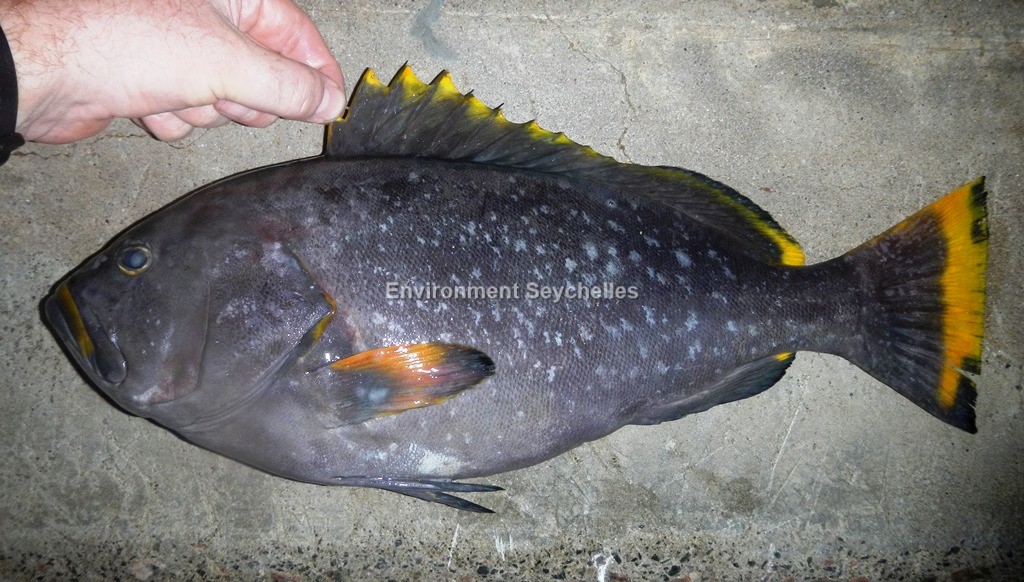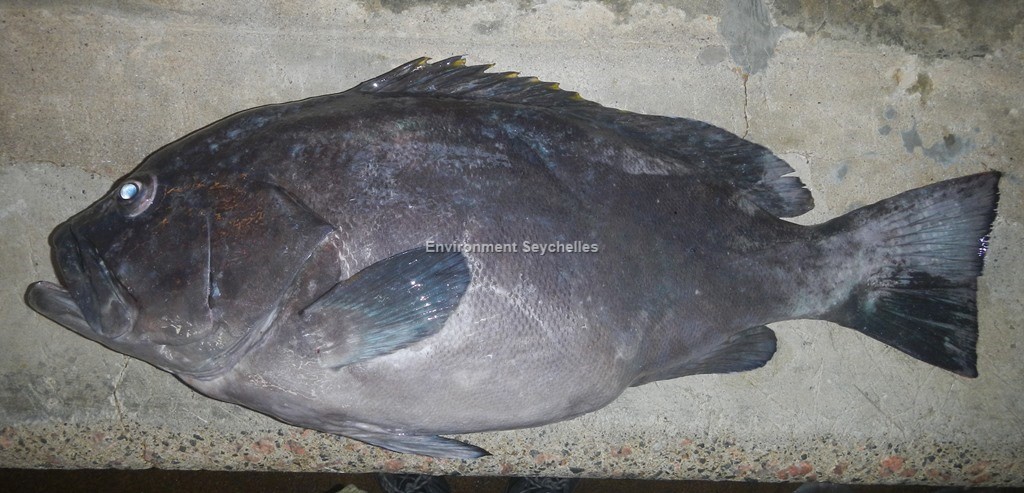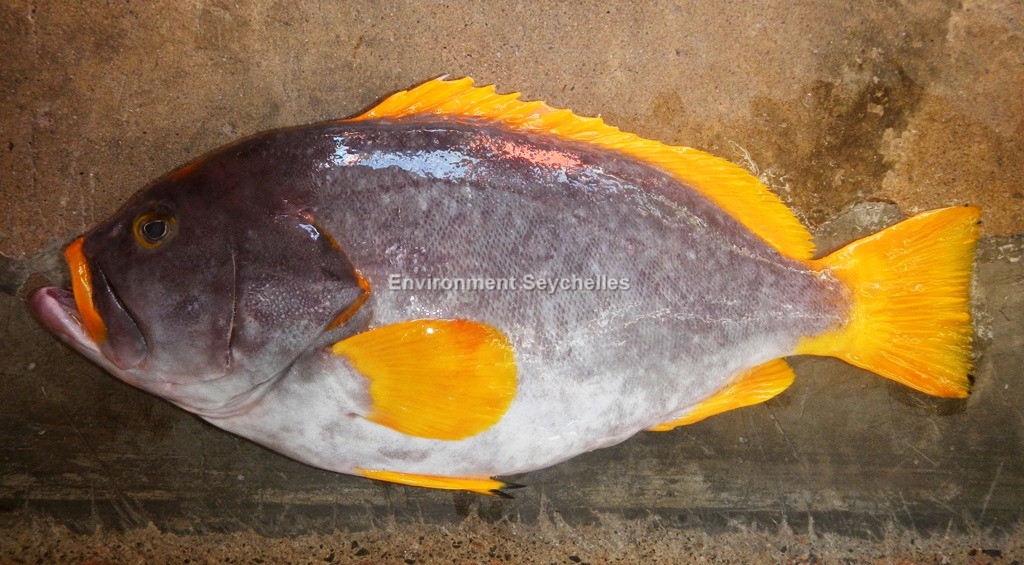Description:
Dorsal spines : 11; Dorsal rays: 16-17; Anal spines: 3; Anal rays: 8.
Large full-bodied grouper. Adults posterior nostrils 4-5 times larger than anterior nostrils. Posterior edge of maxilla reaches to or slightly past vertical at rear edge of
eye. 2-4 rows of teeth on midlateral part of lower jaw. Straight to slightly convex upper edge of operculum. Truncate to slightly emarginate caudal fin.
Colour. Juveniles light grey-blue body with bright yellow fins, lips and sometimes foreheads. Yellow colouration diminishes with growth, though many retain yellow tips to
their fins, may remain pale grey or body darkens to dark grayish, brown, slate blue or almost black. Some specimens in the grey to blue grey spectrum may be flecked with pale
blue. In some fish the corners of the caudal fin, the margin of the soft dorsal and anal fins and the tips of the pelvic fins are blackish.
Size:
Maturity: Lm unknown. Range 49-? cm. Max Length: at least 90.0 cm TL
(One specimen recorded in Seychelles, during a 2-year catch survey 2017/18, measured 96.5 cm TL – J. Nevill artisanal catch database).
Habitat and Ecology:
Reef associated species (depth 10-150 m) juveniles frequent shallower reefs and adults are found on deeper coral and rocky reefs. Feeds on a variety of fishes, crabs, shrimps,
spiny lobsters; squid and small octopodes. Solitary and possibly protogynous.
Fishery Status:
This species is not protected or subject to fishery regulations. It is caught in the handline and fish trap fishery, it is a common component of the catch and on occasion
numerous. It is the most common of the large groupers in the catch. Its size and value make it a species of economic significance to fishers.
Notes:
E. flavocaeruleus is similar in appearance and closely related to E. multinotatus and the two species are not distinguished by fishers sharing the same Creole name of
“Vyey Plat”. The only significant differences are their colour patterns. E multinotatus does not attain a deep blue hue and has numerous small brown spots on its lower head,
flanks and stomach. It is also typified by diffuse white blotches on the body as opposed to pale flecks. E. undulosus is also called "Vyey plat" and not distinguished by
fishers.
References:
Craig, M.T. et al. (2011). Groupers of the World - a field and market guide. NISC (Pty) Ltd, South Africa. ISBN: 978-1-920033-11-8
Froese, R. & D. Pauly. (Eds). (2018). FishBase. http://www.fishbase.se/summary/7345 (07/01/19).
Heemstra, P.C. & Randall, J.E. (1993). Groupers of the World. Vol. 16 FAO Species Catalogue. FAO Fisheries Synopsis No. 125, Volume 16. FIR/S125 Vol. 16
Nevill, J. (2013). A Species Identification Guide for Commonly Caught Fish in the Seychelles Near-Shore Artisanal Fishery. GOS/UNDP/GEF.
Samoilys, M. (2018). Epinephelus flavocaeruleus. The IUCN Red 2018: http://dx.doi.org/10.2305/IUCN.UK.2018-2.RLTS.T132726A100545091.en. (07/01/19).
Citation:
Nevill, J.E.G. (2019). Epinephelus flavocaeruleus, Blue-and-yellow grouper. Seychelles Seatizens. www.seatizens.sc. https://seatizens.sc/species/epinephelus-flavocaeruleus-lacepede-1802/ (edited 27/07/22).




pin-up cazino: pin up giris – pin up 306
http://northern-doctors.org/# mexico pharmacy
pharmacies in mexico that ship to usa northern doctors best online pharmacies in mexico
mexican online pharmacies prescription drugs: mexican pharmacy online – mexican pharmacy
https://northern-doctors.org/# medicine in mexico pharmacies
best online pharmacies in mexico mexico drug stores pharmacies mexico drug stores pharmacies
mexican pharmacy: mexican pharmacy – buying prescription drugs in mexico online
https://northern-doctors.org/# medication from mexico pharmacy
mexico pharmacies prescription drugs: northern doctors – mexican pharmaceuticals online
http://northern-doctors.org/# mexico pharmacy
https://northern-doctors.org/# purple pharmacy mexico price list
reputable mexican pharmacies online northern doctors buying prescription drugs in mexico
https://northern-doctors.org/# mexican pharmaceuticals online
pharmacies in mexico that ship to usa: mexican northern doctors – buying prescription drugs in mexico
mexican drugstore online mexican pharmacy northern doctors mexican online pharmacies prescription drugs
https://northern-doctors.org/# reputable mexican pharmacies online
medicine in mexico pharmacies: northern doctors – mexico pharmacies prescription drugs
http://northern-doctors.org/# mexican online pharmacies prescription drugs
mexico drug stores pharmacies: northern doctors – mexican drugstore online
mexican pharmacy: mexican pharmacy northern doctors – reputable mexican pharmacies online
https://northern-doctors.org/# mexico pharmacies prescription drugs
medicine in mexico pharmacies: mexican northern doctors – mexican rx online
п»їbest mexican online pharmacies: mexican northern doctors – mexican pharmacy
best online pharmacies in mexico mexican pharmacy mexican mail order pharmacies
mexico drug stores pharmacies: mexican pharmacy online – buying prescription drugs in mexico online
medicine in mexico pharmacies: mexican pharmacy northern doctors – mexico drug stores pharmacies
Excellent insights! Your breakdown of the topic is clear and concise. For further reading, check out this link: READ MORE. Let’s discuss!
mexican mail order pharmacies: mexico pharmacy – mexican online pharmacies prescription drugs
mexican pharmaceuticals online: mexican pharmacy northern doctors – best online pharmacies in mexico
best online pharmacies in mexico: mexican northern doctors – mexican online pharmacies prescription drugs
mexican pharmacy: northern doctors – mexican online pharmacies prescription drugs
mexico drug stores pharmacies mexican northern doctors buying from online mexican pharmacy
https://northern-doctors.org/# pharmacies in mexico that ship to usa
pharmacies in mexico that ship to usa: buying from online mexican pharmacy – mexican online pharmacies prescription drugs
purple pharmacy mexico price list: mexican pharmacy online – purple pharmacy mexico price list
buying prescription drugs in mexico: northern doctors – mexican rx online
mexican border pharmacies shipping to usa: mexican pharmacy northern doctors – mexican rx online
mexico pharmacy: mexican pharmacy – mexican pharmacy
best online pharmacies in mexico mexican northern doctors best online pharmacies in mexico
mexican pharmacy: Mexico pharmacy that ship to usa – mexico pharmacy
medicine in mexico pharmacies: mexican pharmacy – medication from mexico pharmacy
mexican mail order pharmacies: northern doctors pharmacy – reputable mexican pharmacies online
http://foruspharma.com/# medicine in mexico pharmacies
real canadian pharmacy: canada pharmacy – canada pharmacy world
canada pharmacy online: ed drugs online from canada – reliable canadian pharmacy reviews
maple leaf pharmacy in canada: canadian valley pharmacy – best online canadian pharmacy
http://foruspharma.com/# medication from mexico pharmacy
canadian pharmacy com: best canadian pharmacy to buy from – canadian pharmacy meds
mexican mail order pharmacies mexico pharmacy п»їbest mexican online pharmacies
world pharmacy india: online pharmacy india – india online pharmacy
reputable indian pharmacies: buy medicines online in india – top 10 pharmacies in india
mexico drug stores pharmacies: mexican rx online – mexico pharmacy
https://canadapharmast.online/# canada pharmacy online
п»їbest mexican online pharmacies mexican drugstore online mexican rx online
cheapest online pharmacy india: cheapest online pharmacy india – best online pharmacy india
buy medicines online in india: top 10 online pharmacy in india – top 10 online pharmacy in india
Way cool! Some extremely valid points! I appreciate you penning this article plus the rest of the website is very good.
global pharmacy canada: canadian 24 hour pharmacy – canada rx pharmacy world
canadian drug prices: canada drug pharmacy – canadian pharmacy store
buy cipro online usa: buy cipro cheap – cipro online no prescription in the usa
http://ciprodelivery.pro/# ciprofloxacin 500mg buy online
Hi there! I could have sworn I’ve been to this blog before but after browsing through many of the articles I realized it’s new to me. Anyways, I’m definitely happy I found it and I’ll be bookmarking it and checking back regularly.
where can i buy amoxicillin over the counter uk: buy amoxicillin over the counter uk – amoxicillin 500mg capsules uk
Nice post. I learn something totally new and challenging on sites I stumbleupon every day. It will always be interesting to read articles from other writers and practice a little something from their websites.
http://doxycyclinedelivery.pro/# doxy 100
buy cipro without rx: cipro – where can i buy cipro online
https://doxycyclinedelivery.pro/# doxycycline 100mg price uk
http://amoxildelivery.pro/# buy amoxicillin online with paypal
buy cipro without rx: buy cipro online canada – buy cipro without rx
http://clomiddelivery.pro/# cost of generic clomid tablets
https://amoxildelivery.pro/# amoxicillin generic
can i get generic clomid price: can you get clomid for sale – where can i buy cheap clomid
https://ciprodelivery.pro/# purchase cipro
I was able to find good information from your content.
where can i buy cipro online: ciprofloxacin mail online – buy cipro cheap
http://amoxildelivery.pro/# where to get amoxicillin over the counter
doxycycline 100mg tablets cost: price of doxycycline in india – doxycycline 50 medicine
п»їpaxlovid: paxlovid covid – buy paxlovid online